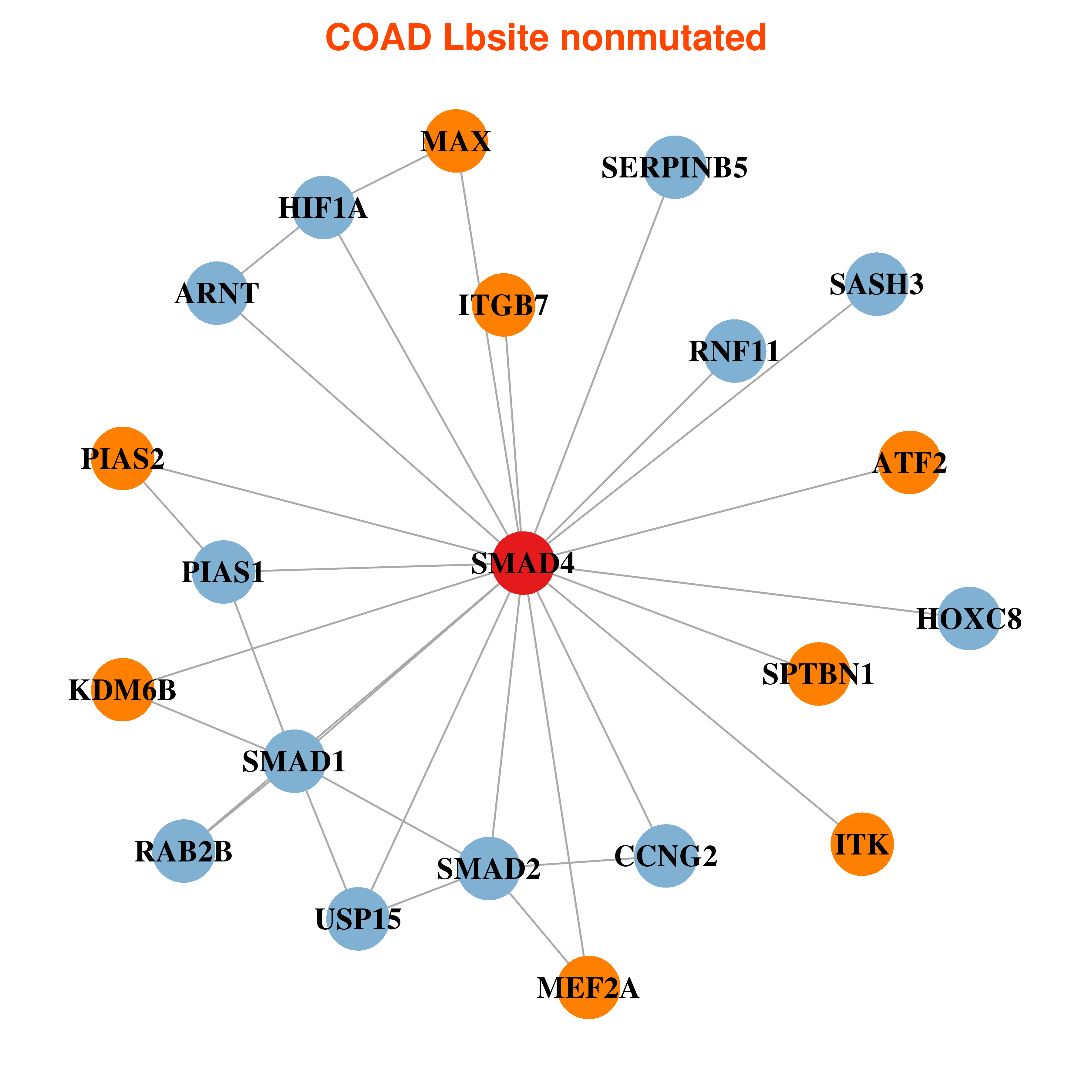|
mutLBSgeneDB |
| |
| |
| |
| |
| |
| |
|
| Gene summary for SMAD4 |
 Gene summary Gene summary |
| Basic gene Info. | Gene symbol | SMAD4 |
| Gene name | SMAD family member 4 | |
| Synonyms | DPC4|JIP|MADH4|MYHRS | |
| Cytomap | UCSC genome browser: 18q21.1 | |
| Type of gene | protein-coding | |
| RefGenes | NM_005359.5, | |
| Description | MAD homolog 4SMAD, mothers against DPP homolog 4deleted in pancreatic carcinoma locus 4deletion target in pancreatic carcinoma 4mothers against decapentaplegic homolog 4mothers against decapentaplegic, Drosophila, homolog of, 4 | |
| Modification date | 20141222 | |
| dbXrefs | MIM : 600993 | |
| HGNC : HGNC | ||
| Ensembl : ENSG00000141646 | ||
| HPRD : 02995 | ||
| Vega : OTTHUMG00000132696 | ||
| Protein | UniProt: Q13485 go to UniProt's Cross Reference DB Table | |
| Expression | CleanEX: HS_SMAD4 | |
| BioGPS: 4089 | ||
| Pathway | NCI Pathway Interaction Database: SMAD4 | |
| KEGG: SMAD4 | ||
| REACTOME: SMAD4 | ||
| Pathway Commons: SMAD4 | ||
| Context | iHOP: SMAD4 | |
| ligand binding site mutation search in PubMed: SMAD4 | ||
| UCL Cancer Institute: SMAD4 | ||
| Assigned class in mutLBSgeneDB | B: This gene belongs to targetable_mutLBSgenes. | |
 Gene ontology having evidence of Inferred from Direct Assay (IDA) from Entrez Gene ontology having evidence of Inferred from Direct Assay (IDA) from Entrez |
| GO ID | GO Term | PubMed ID | GO:0007179 | transforming growth factor beta receptor signaling pathway | 9389648 | GO:0007183 | SMAD protein complex assembly | 10823886 | GO:0030308 | negative regulation of cell growth | 8774881 | GO:0030509 | BMP signaling pathway | 9389648 | GO:0030511 | positive regulation of transforming growth factor beta receptor signaling pathway | 19328798 | GO:0035556 | intracellular signal transduction | 9389648 | GO:0045892 | negative regulation of transcription, DNA-templated | 8774881 | GO:0045893 | positive regulation of transcription, DNA-templated | 8774881 | GO:0045944 | positive regulation of transcription from RNA polymerase II promoter | 18832382 | GO:0060395 | SMAD protein signal transduction | 9707553 | GO:0071559 | response to transforming growth factor beta | 9707553 |
| Top |
| Ligand binding site mutations for SMAD4 |
 Lollipop-style diagram of mutations at LBS in amino-acid sequence. Lollipop-style diagram of mutations at LBS in amino-acid sequence. We represented ligand binding site mutations only. (You can see big image via clicking.) |
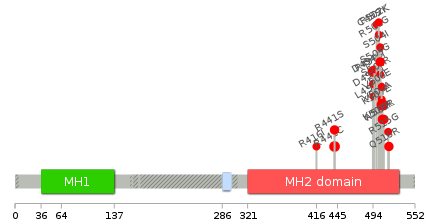 |
 Cancer type specific mutLBS sorted by frequency Cancer type specific mutLBS sorted by frequency |
| LBS | AAchange of nsSNV | Cancer type | # samples | K507 | K507E | COAD | 6 | R496 | D494G | COAD | 4 | Q442 | R441C | COAD | 4 | Q442 | R441S | COAD | 2 | R515 | Q516R | COAD | 2 | K507 | K507R | COAD | 2 | K507 | W509R | COAD | 2 | R502 | S504G | COAD | 2 | R502 | S504I | COAD | 1 | K507 | V506E | COAD | 1 | R416 | R416I | COAD | 1 | R496 | R496H | COAD | 1 | K507 | V506A | COAD | 1 | R515 | R515G | COAD | 1 | R502 | R502K | COAD | 1 | R496 | D494N | COAD | 1 | R502 | R502G | COAD | 1 | R496 | L495R | COAD | 1 | R502 | S504R | PRAD | 1 | R497 | C499Y | STAD | 1 |
| cf) Cancer type abbreviation. BLCA: Bladder urothelial carcinoma, BRCA: Breast invasive carcinoma, CESC: Cervical squamous cell carcinoma and endocervical adenocarcinoma, COAD: Colon adenocarcinoma, GBM: Glioblastoma multiforme, LGG: Brain lower grade glioma, HNSC: Head and neck squamous cell carcinoma, KICH: Kidney chromophobe, KIRC: Kidney renal clear cell carcinoma, KIRP: Kidney renal papillary cell carcinoma, LAML: Acute myeloid leukemia, LUAD: Lung adenocarcinoma, LUSC: Lung squamous cell carcinoma, OV: Ovarian serous cystadenocarcinoma, PAAD: Pancreatic adenocarcinoma, PRAD: Prostate adenocarcinoma, SKCM: Skin cutaneous melanoma, STAD: Stomach adenocarcinoma, THCA: Thyroid carcinoma, UCEC: Uterine corpus endometrial carcinoma. |
 Clinical information for SMAD4 from My Cancer Genome. Clinical information for SMAD4 from My Cancer Genome. |
| SMAD4, SMAD family member 4, is one of eight SMAD proteins in the human genome (Massague 1998). SMAD4 is sometimes referred to as DPC4 (Hahn et al. 1996). SMAD4 is a signal transduction protein that is the central mediator for downstream transcriptional output in the TGF-β family signaling pathways via its interaction with upstream receptors and fellow SMAD transcription factors (Goustin et al. 1986; Tucker et al. 1984a; Tucker et al. 1984b). The TGF-β pathway plays a complex role in cancer development, progression, and metastasis (Bierie and Moses 2006; Elliott and Blobe 2005; Massague 2008; Miyaki and Kuroki 2003).SMAD4 consists of two domains connected by a linker region (Shi and Massague 2003). MAD homology domain 1 (MH1) is the N-terminal, DNA-binding domain (NCBI Gene Database). MAD homology domain 2 (MH2) is the C-terminal domain that interacts with upstream receptors and mediates oligomerization and transactivation to provide specificity and selectivity (NCBI Gene Database). Smad4 is made up of 11 coding exons.Mutations in SMAD4 are involved in several hereditary syndromes with cancer predisposition, including juvenile polyposis syndrome and hemorrhagic hereditary telangiectasia (HHT) syndrome. SMAD4 loss or mutation is also seen in approximately 50% of pancreatic tumors and in 10–35% of invasive CRC (Elliott and Blobe 2005; Hahn et al. 1996;Miyaki et al. 1999). The MH2, C-terminal domain of SMAD4 is the target of tumorigenic inactivation, and mutations in this region disrupt RSMAD oligomerization, which interrupts normal signaling pathways (Shi et al. 1997; Shi and Massague 2003).Beauchamp, R., Chan, E., Stover, D.G., Smith, J., Freeman, T.J. 2015. SMAD4. My Cancer Genome https://www.mycancergenome.org/content/gene/smad4/ (Updated December 2015) |
| Top |
| Protein structure related information for SMAD4 |
 Relative protein structure stability change (ΔΔE) using Mupro 1.1 Relative protein structure stability change (ΔΔE) using Mupro 1.1 Mupro score denotes assessment of the effect of mutations on thermodynamic stability. (ΔΔE<0: mutation decreases stability, ΔΔE>0: mutation increases stability) |
 : nsSNV at non-LBS : nsSNV at non-LBS : nsSNV at LBS : nsSNV at LBS |
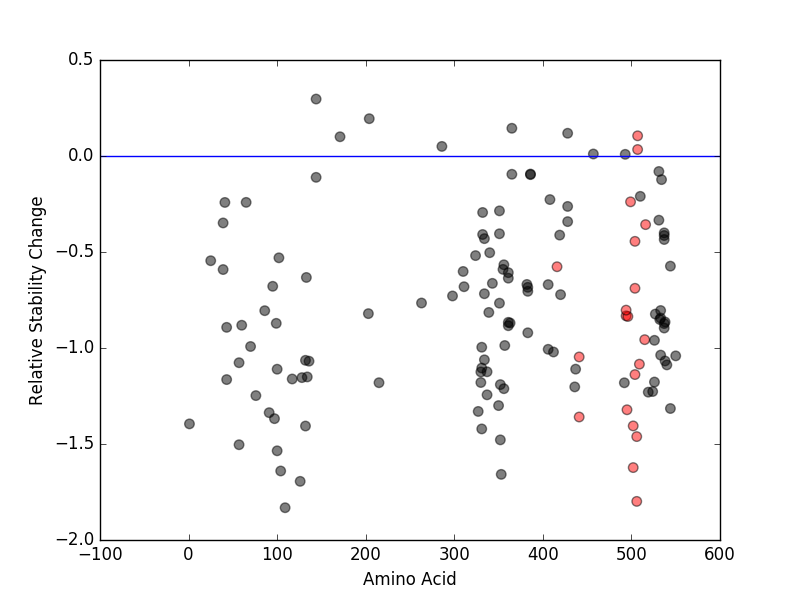 |
 nsSNVs sorted by the relative stability change of protein structure by each mutation nsSNVs sorted by the relative stability change of protein structure by each mutation Blue: mutations of positive stability change. and red : the most recurrent mutation for this gene. |
| LBS | AAchange of nsSNV | Relative stability change | K507 | K507R | 0.10518294 | K507 | K507E | 0.033821158 | K507 | V506A | -1.7989071 | R502 | R502G | -1.6228458 | K507 | V506E | -1.4614304 | R502 | R502K | -1.4057908 | Q442 | R441S | -1.3593812 | R496 | L495R | -1.3216992 | R502 | S504G | -1.1383694 | K507 | W509R | -1.0841622 | Q442 | R441C | -1.0465917 | R515 | R515G | -0.95656464 | R496 | R496H | -0.83577686 | R496 | D494G | -0.83266113 | R496 | D494N | -0.80277225 | R502 | S504R | -0.68903678 | R416 | R416I | -0.57677179 | R502 | S504I | -0.44450731 | R515 | Q516R | -0.35740712 | R497 | C499Y | -0.23871481 |
| (MuPro1.1: Jianlin Cheng et al., Prediction of Protein Stability Changes for Single-Site Mutations Using Support Vector Machines, PROTEINS: Structure, Function, and Bioinformatics. 2006, 62:1125-1132) |
 Structure image for SMAD4 from PDB Structure image for SMAD4 from PDB |
| PDB ID | PDB title | PDB structure | 1DD1 | CRYSTAL STRUCTURE ANALYSIS OF THE SMAD4 ACTIVE FRAGMENT | 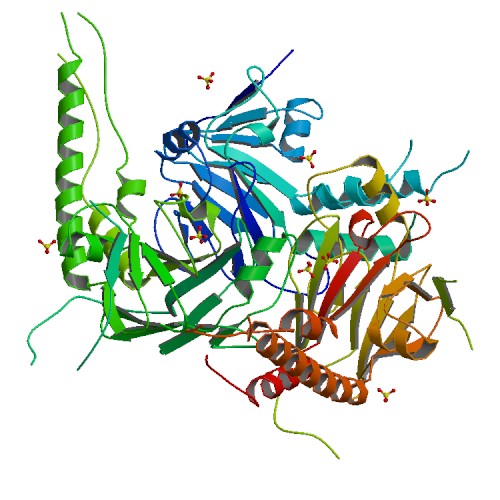 |
| Top |
| Differential gene expression and gene-gene network for SMAD4 |
 Differential gene expression between mutated and non-mutated LBS samples in all 16 major cancer types Differential gene expression between mutated and non-mutated LBS samples in all 16 major cancer types |
| SMAD4_COAD_DE |
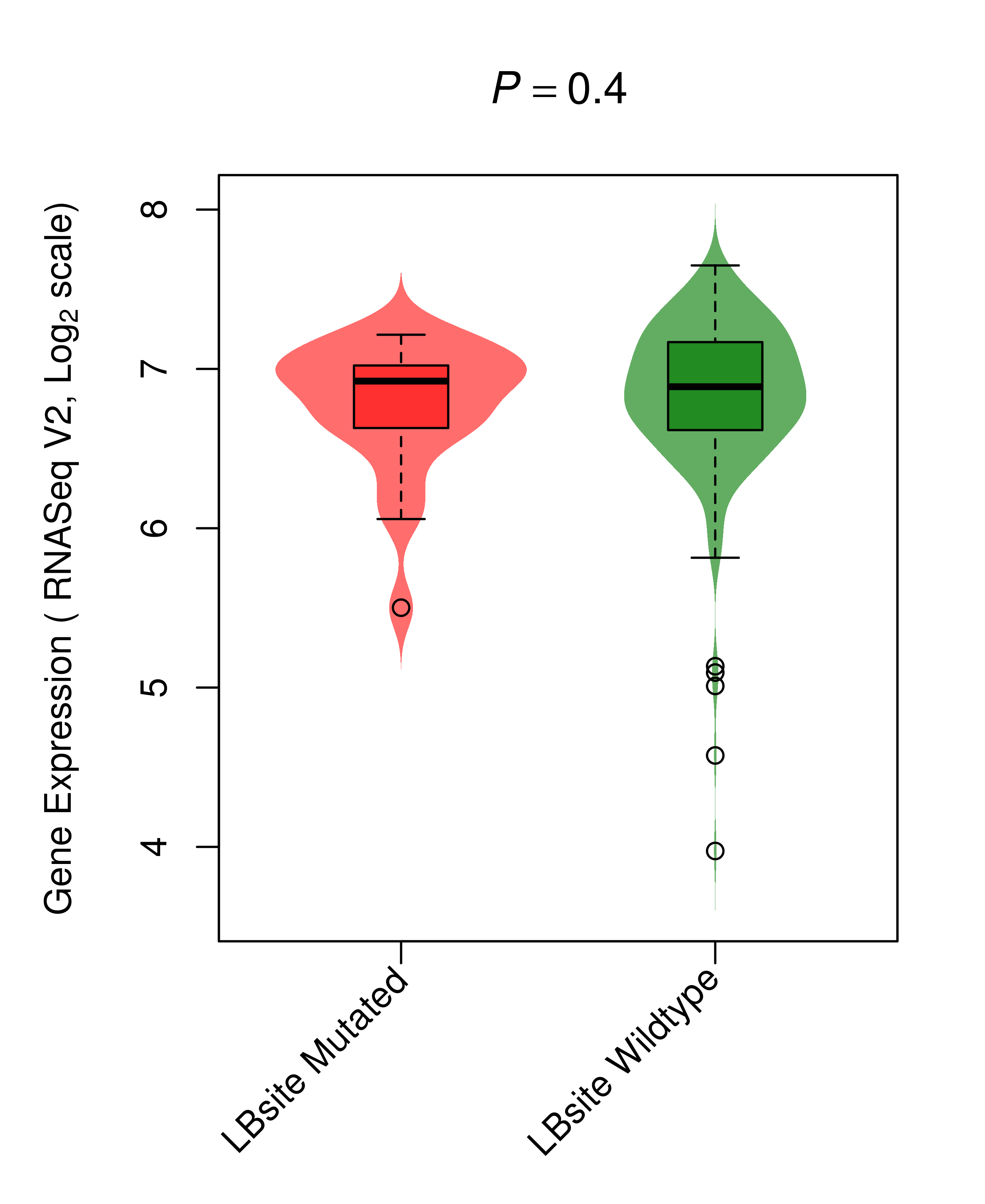 |
 Differential co-expressed gene network based on protein-protein interaction data (CePIN) Differential co-expressed gene network based on protein-protein interaction data (CePIN) |
| * In COAD | |
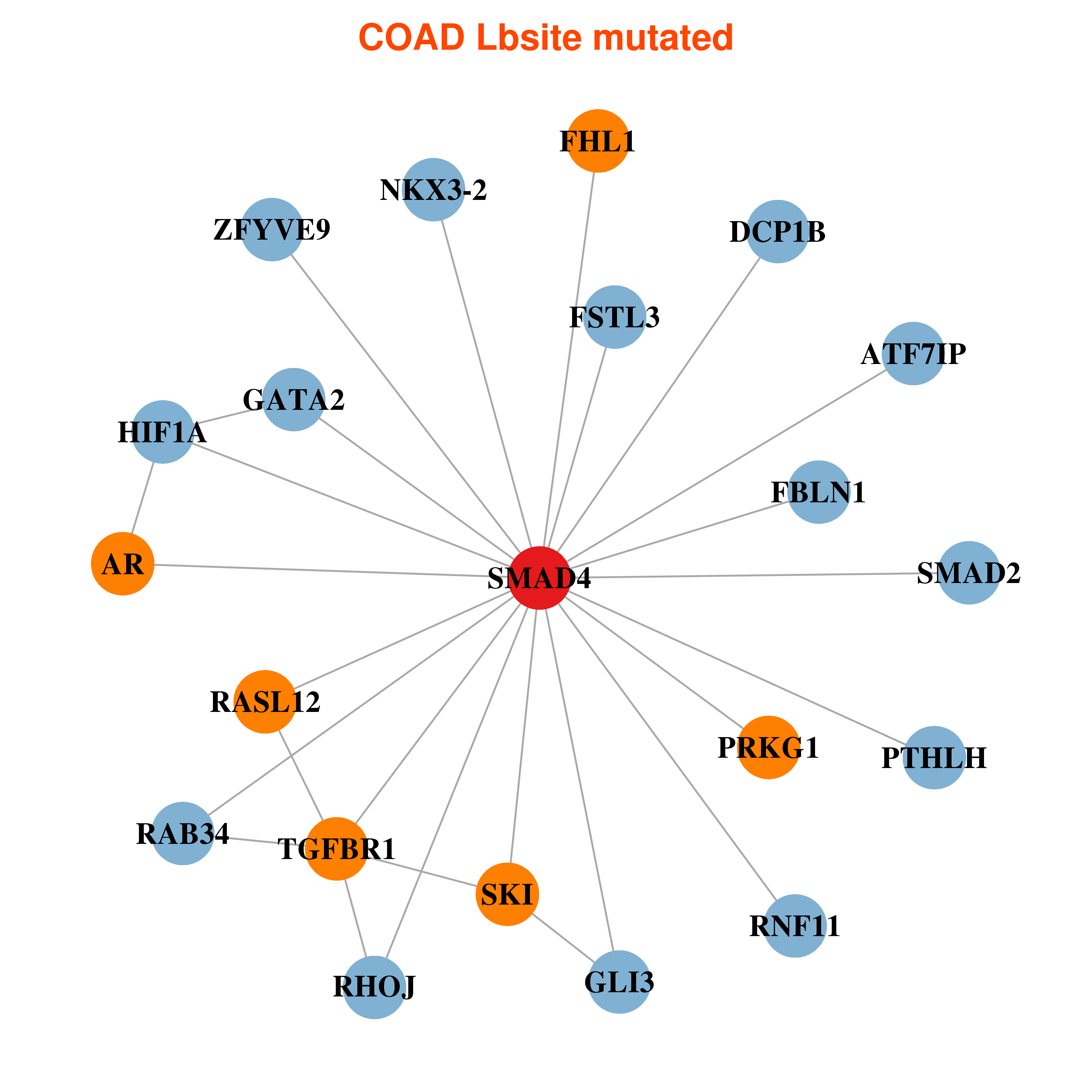 |
|
| Top |
| Top |
| Phenotype information for SMAD4 |
 Gene level disease information (DisGeNet) Gene level disease information (DisGeNet) |
| Disease ID | Disease name | # PubMed | Association type |
| umls:C0345893 | Juvenile polyposis syndrome | 66 | Biomarker, GeneticVariation |
| umls:C0235974 | Pancreatic Carcinoma | 66 | Biomarker, GeneticVariation |
| umls:C0009404 | Colorectal Neoplasms | 15 | AlteredExpression, Biomarker, GeneticVariation |
| umls:C0279628 | Adenocarcinoma Of Esophagus | 5 | Biomarker, GeneticVariation |
| umls:C0796081 | Growth mental deficiency syndrome of Myhre | 4 | Biomarker, GeneticVariation |
| umls:C1832942 | Juvenile Polyposis with Hereditary Hemorrhagic Telangiectasia | 4 | Biomarker, GeneticVariation |
| umls:C1134719 | Carcinoma, Ductal, Breast | 3 | Biomarker |
| umls:C0038356 | Stomach Neoplasms | 2 | Biomarker, GeneticVariation |
| umls:C0206698 | Cholangiocarcinoma | 2 | Biomarker |
| umls:C0221357 | Brachydactyly | 1 | Biomarker |
| umls:C0009241 | Cognition Disorders | 1 | Biomarker |
| umls:C0376634 | Craniofacial Abnormalities | 1 | Biomarker |
| umls:C0011053 | Deafness | 1 | Biomarker |
| umls:C0023893 | Liver Cirrhosis, Experimental | 1 | Biomarker |
| umls:C0023897 | Liver Diseases, Parasitic | 1 | Biomarker |
| umls:C0026848 | Muscular Diseases | 1 | Biomarker |
| umls:C0027672 | Neoplastic Syndromes, Hereditary | 1 | GeneticVariation |
 Mutation level pathogenic information (ClinVar annotation) Mutation level pathogenic information (ClinVar annotation) |
| Allele ID | AA change | Clinical significance | Origin | Phenotype IDs |
| 36200 | W509R | Pathogenic | Not provided | GeneReviews:NBK1469 MedGen:C0345893 OMIM:174900 Orphanet:ORPHA2929 SNOMED CT:9273005 |
| 185455 | Q516R | Uncertain significance | Germline | MedGen:C0027672 SNOMED CT:699346009 |
| Top |
| Pharmacological information for SMAD4 |
 Gene expression profile of anticancer drug treated cell-lines (CCLE) Gene expression profile of anticancer drug treated cell-lines (CCLE)Heatmap showing the correlation between gene expression and drug response across all the cell-lines. We chose the top 20 among 138 drugs.We used Pearson's correlation coefficient. |
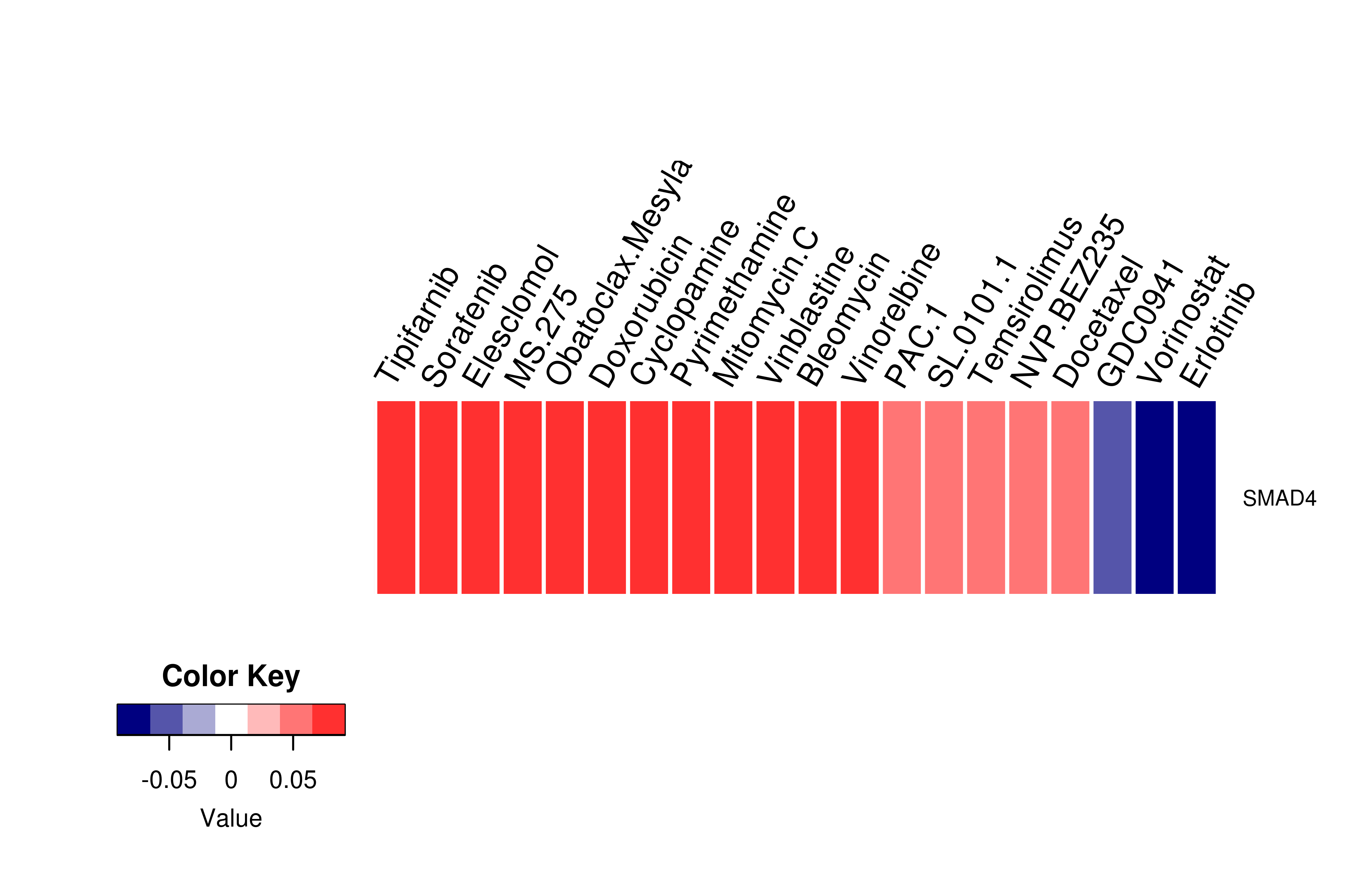 |
 Drug information targeting mutLBSgene (Approved drugs only) Drug information targeting mutLBSgene (Approved drugs only) |
| Drug status | DrugBank ID | Name | Type | Drug structure |
 Gene-centered ligand-gene interaction network Gene-centered ligand-gene interaction network |
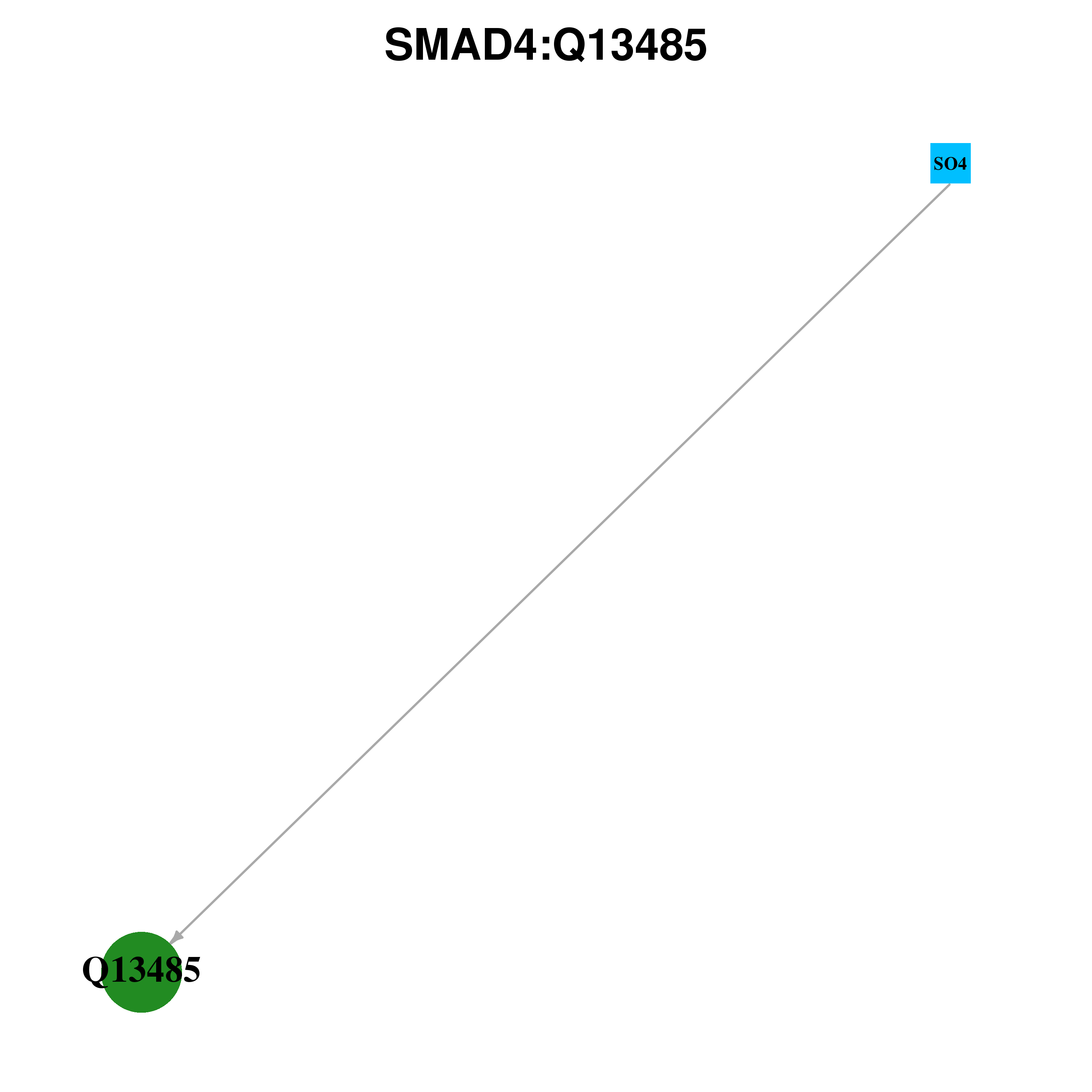 |
 Ligands binding to mutated ligand binding site of SMAD4 go to BioLip Ligands binding to mutated ligand binding site of SMAD4 go to BioLip |
| Ligand ID | Ligand short name | Ligand long name | PDB ID | PDB name | mutLBS | SO4 | SULFATE | 1dd1 | A | K507 R515 | SO4 | SULFATE | 1dd1 | B | K507 R515 | SO4 | SULFATE | 1dd1 | C | K507 R515 | SO4 | SULFATE | 1dd1 | B | R416 Q442 | SO4 | SULFATE | 1dd1 | C | R416 Q442 | SO4 | SULFATE | 1dd1 | C | R496 R497 R502 |
| Top |
| Conservation information for LBS of SMAD4 |
 Multiple alignments for Q13485 in multiple species Multiple alignments for Q13485 in multiple species |
| LBS | AA sequence | # species | Species | K507 | RMSFVKGWGPD | 4 | Homo sapiens, Bos taurus, Rattus norvegicus, Mus musculus | N369 | LGQLSNVHRTE | 4 | Homo sapiens, Bos taurus, Rattus norvegicus, Mus musculus | P514 | WGPDYPRQSIK | 4 | Homo sapiens, Bos taurus, Rattus norvegicus, Mus musculus | Q442 | VFDLRQCHRQM | 4 | Homo sapiens, Bos taurus, Rattus norvegicus, Mus musculus | Q446 | RQCHRQMQQQA | 4 | Homo sapiens, Bos taurus, Rattus norvegicus, Mus musculus | R372 | LSNVHRTEAIE | 4 | Homo sapiens, Bos taurus, Rattus norvegicus, Mus musculus | R416 | SYYLDREAGRA | 4 | Homo sapiens, Bos taurus, Rattus norvegicus, Mus musculus | R445 | LRQCHRQMQQQ | 4 | Homo sapiens, Bos taurus, Rattus norvegicus, Mus musculus | R496 | GVDDLRRLCIL | 4 | Homo sapiens, Bos taurus, Rattus norvegicus, Mus musculus | R497 | VDDLRRLCILR | 4 | Homo sapiens, Bos taurus, Rattus norvegicus, Mus musculus | R502 | RLCILRMSFVK | 4 | Homo sapiens, Bos taurus, Rattus norvegicus, Mus musculus | R515 | GPDYPRQSIKE | 4 | Homo sapiens, Bos taurus, Rattus norvegicus, Mus musculus | S368 | CLGQLSNVHRT | 4 | Homo sapiens, Bos taurus, Rattus norvegicus, Mus musculus |
 |
Copyright © 2016-Present - The University of Texas Health Science Center at Houston |

